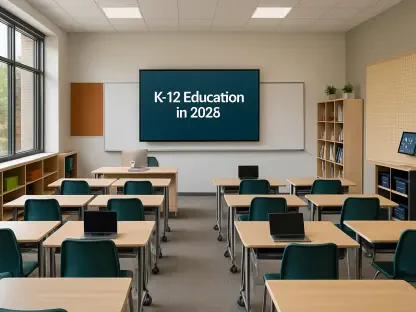In the rapidly evolving landscape of digital education, global online language learning platforms have emerged as a key driver of linguistic proficiency worldwide. With the market valued at $9.34 billion in 2022 and an impressive upward trajectory predicting a rise to $44.8 billion by 2032, the demand for language learning through digital platforms is growing at an astounding compound annual growth rate (CAGR) of 17.2%. This surge is predominantly fueled by globalization, which necessitates improved language skills for personal and professional growth. The shift towards online platforms is primarily attributed to the flexibility, accessibility, and convenience they offer compared to traditional classroom-based learning. These platforms break geographical boundaries, allowing learners globally to acquire new languages at their own pace and convenience, thus making language skills more indispensable in today’s interconnected world.
Factors Driving Market Growth
Several pivotal factors are acting as catalysts to the robust growth of online language learning platforms. The proliferation of high-speed internet and widespread availability of digital devices such as smartphones and tablets have eliminated geographical barriers, bringing language education to users’ fingertips. This digital transformation supports the increasing accessibility of language resources, broadening the audience that can partake in such learning opportunities. Another significant contributor is the integration of artificial intelligence (AI) into language learning platforms. AI’s role in enhancing the personalization of language courses ensures a tailored learning experience, addressing specific needs and preferences of individual users. This personalization, combined with the evolving capabilities of language education technologies, is transforming digital platforms into a favored avenue for language acquisition among learners worldwide.
Within the market, distinct segments are shaping the industry’s future directions. The digital self-tutoring segment stood out in 2022, leading the market with more than three-fifths of the total revenue. Its prominence is maintained by leveraging cutting-edge technologies like Virtual Reality (VR) and Augmented Reality (AR). These technologies create immersive experiences that simulate real-world interactions, offering practical advantages in language learning by enhancing engagement and contextual comprehension. Moreover, advancements in natural language processing (NLP) technologies significantly improve the quality and interactivity of these applications, providing users with more refined learning tools. These innovative methods attract and retain learners by making language acquisition an engaging and efficient process.
Emergence of Live Learning Platforms
Despite the dominance of digital self-tutoring platforms, live learning segments are poised to experience the fastest growth, marked by a projected CAGR of 18.8% from 2025 to 2032. The allure of live learning environments stems from their ability to facilitate interactive communication, fostering essential speaking and listening skills. These platforms often incorporate engaging methods such as group discussions, debates, role plays, and collaborative projects, which not only enhance understanding but also boost learners’ confidence in using new languages. Live platforms capitalize on real-time interaction with tutors and peers, making the learning experience dynamic and socially enriching. This aspect is particularly crucial for those who benefit from comprehensive, interactive learning that resembles traditional classroom settings, but with the added advantages of digital connectivity and flexibility.
Another factor contributing to the attractiveness of live learning is the potential for immediate feedback, which allows learners to adjust and refine their language skills in a supportive environment. The interactive nature of these platforms not only enhances the speed and efficacy of language acquisition but also ensures sustained learner engagement. As language learners become more discerning, the demand for increasingly sophisticated learning environments is likely to propel the continued growth of the live learning segment, further diversifying the offerings within the digital language education market.
Language Preferences and Market Dynamics
The demand for language acquisition is influenced by learners’ preferences and the global importance of certain languages. English remains the most sought-after language, maintaining the largest market share in 2022. Its global standing as a lingua franca in business, academia, and technology drives this demand, making proficiency in English often a prerequisite for various educational and professional pursuits. However, a notable shift toward learning Chinese is on the horizon, with this segment predicted to register an impressive CAGR of 21.3% from 2025 to 2032. The increased interest in Chinese is largely driven by China’s expanding influence in international trade and diplomacy. Additionally, fields like international relations and Asian studies underscore the strategic value of Mandarin proficiency. This growing interest in Mandarin reflects a broader trend where educational curricula worldwide are broadening their language offerings to meet the demands of an increasingly multipolar global landscape.
In analyzing end-user segments, educational institutions hold a significant share of the market. By adopting digital platforms, these institutions reduce the need for physical infrastructures, leading to cost-effective language instruction. Many platforms now offer adaptive learning technologies that align with individual learners’ proficiency levels, facilitating personalized educational experiences. This trend towards integrating technology in educational environments aligns with the shift in pedagogical paradigms favoring digital classrooms. Conversely, the individuals’ segment, which encompasses self-motivated learners pursuing language skills for personal growth, cross-cultural communication, or improved career prospects, is anticipated to witness the highest growth rate.
Regional Trends and Market Leaders
Geographically, North America led in market revenue in 2022, accounting for nearly two-fifths of global revenue. This predominance reflects the region’s proactive approach toward online language learning, driven by personal and professional aspirations of its diverse population. Such motivations underscore North America’s dedication to multilingual capacities, given the cultural plurality and global mobility of its citizens. However, the Asia-Pacific region is set to experience the most significant growth in the coming years, with a forecasted CAGR of 20.7% from 2025 to 2032. This region’s emphasis on English proficiency, due to its role as a cornerstone in global communication and commerce, propels the demand for comprehensive language learning. The rising economic and cultural exchanges between Asia-Pacific countries and the rest of the world also contribute to this high growth trajectory.
Prominent market players such as Rosetta Stone LLC, Babbel GmbH, and Busuu Ltd, among others, continue to shape the market with dynamic strategies, including new product launches and strategic partnerships. These companies’ initiatives to expand their reach and enhance their platform capabilities play a vital role in sustaining their competitive edge and securing market dominance. By leveraging technological advancements and adapting to consumer demands, these players are poised to capitalize on the burgeoning interest in digital language education, solidifying their position both regionally and globally.
Future Prospects in Digital Language Education
Several key factors are fueling the significant expansion of online language learning platforms. The spread of high-speed internet and the widespread use of digital devices like smartphones and tablets have removed traditional barriers, making language learning easily accessible. This digital shift enhances the availability of language resources, making them accessible to a broader audience eager to engage in these learning opportunities. A major driving force behind this trend is the use of artificial intelligence (AI) in online language education. AI’s ability to personalize language courses means that learners receive a customized experience addressing their unique needs, increasing the appeal of these platforms globally.
The market is evolving, with specific segments indicating future trends. In 2022, the digital self-tutoring segment captured more than three-fifths of market revenue. This success largely stems from using advanced technologies like Virtual Reality (VR) and Augmented Reality (AR), which offer engaging, real-world-like experiences. Coupled with natural language processing (NLP) progress, these methods enhance interactivity, making language learning more engaging and effective.









